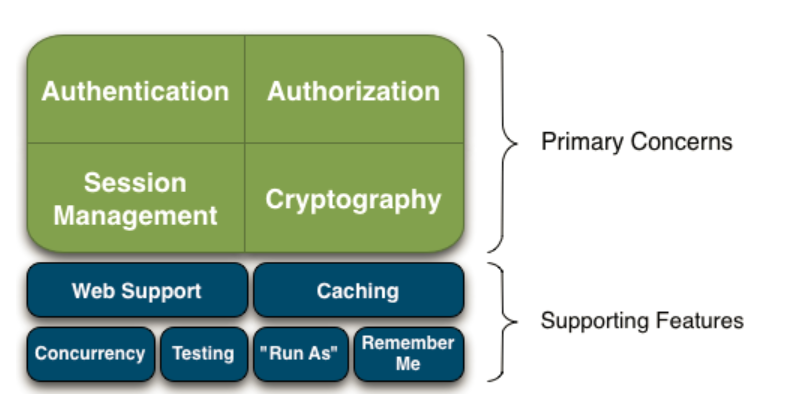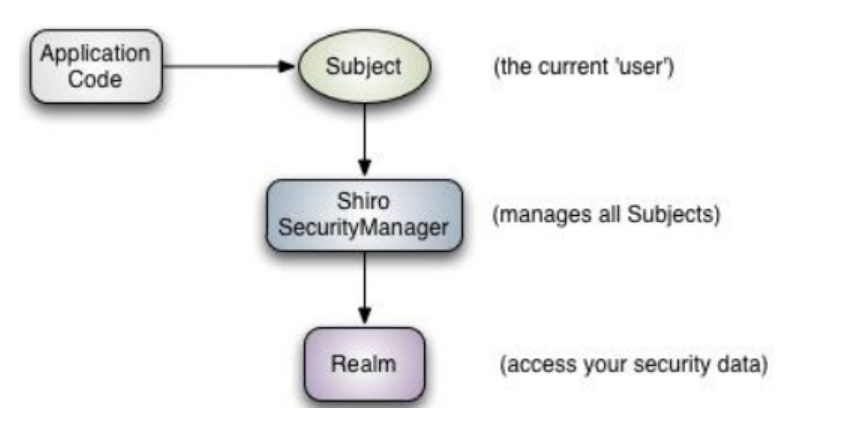Shiro 可以非常容易的开发出足够好的应用,其不仅可以用在 JavaSE 环境,也可以用在 JavaEE 环境。Shiro 可以帮助我们完成:认证、授权、加密、会话管理、与 Web 集成、缓存等。其基本功能点如下图所示:
记住一点,Shiro 不会去维护用户、维护权限;这些需要我们自己去设计 / 提供;然后通过相应的接口注入给 Shiro 即可。
Apache Shiro是一个Java 的安全(权限)框架。Shiro可以非常容易的开发出足够好的应用,其不仅可以用在JavaSE环境,也可以用在JavaEE环境。Shiro可以完成,认证,授权,加密,会话管理,Web集成,缓存等.
我们从外部来看 Shiro ,即从应用程序角度的来观察如何使用 Shiro 完成工作。如下图:

可以看到:应用代码直接交互的对象是 Subject,也就是说 Shiro 的对外 API 核心就是 Subject;其每个 API 的含义:
Subject:主体,代表了当前 “用户”,这个用户不一定是一个具体的人,与当前应用交互的任何东西都Subject,如网络爬虫,机器人等;即一个抽象概念;所有 Subject 都绑定到 SecurityManager,与 Subject 的所有交互都会委托给 SecurityManager;可以把 Subject 认为是一个门面;SecurityManager 才是实际的执行者;
SecurityManager:安全管理器;即所有与安全有关的操作都会与 SecurityManager 交互;且它管理着所有 Subject;可以看出它是 Shiro 的核心,它负责与后边介绍的其他组件进行交互,如果学习过 SpringMVC,你可以把它看成 DispatcherServlet 前端控制器;
Realm:域,Shiro 从 Realm 获取安全数据(如用户、角色、权限),就是说 SecurityManager 要验证用户身份,那么它需要从 Realm 获取相应的用户进行比较以确定用户身份是否合法;也需要从 Realm 得到用户相应的角色 / 权限进行验证用户是否能进行操作;可以把 Realm 看成 DataSource,即安全数据源。
也就是说对于我们而言,最简单的一个 Shiro 应用:
从以上也可以看出,Shiro 不提供维护用户 / 权限,而是通过 Realm 让开发人员自己注入。
接下来我们来从 Shiro 内部来看下 Shiro 的架构,如下图所示:

Subject:主体,可以看到主体可以是任何可以与应用交互的 “用户”;
SecurityManager:相当于 SpringMVC 中的 DispatcherServlet 或者 Struts2 中的 FilterDispatcher;是 Shiro 的心脏;所有具体的交互都通过 SecurityManager 进行控制;它管理着所有 Subject、且负责进行认证和授权、及会话、缓存的管理。
Authenticator:认证器,负责主体认证的,这是一个扩展点,如果用户觉得 Shiro 默认的不好,可以自定义实现;其需要认证策略(Authentication Strategy),即什么情况下算用户认证通过了;
Authrizer:授权器,或者访问控制器,用来决定主体是否有权限进行相应的操作;即控制着用户能访问应用中的哪些功能;
Realm:可以有 1 个或多个 Realm,可以认为是安全实体数据源,即用于获取安全实体的;可以是 JDBC 实现,也可以是 LDAP 实现,或者内存实现等等;由用户提供;注意:Shiro 不知道你的用户 / 权限存储在哪及以何种格式存储;所以我们一般在应用中都需要实现自己的 Realm;
SessionManager:如果写过 Servlet 就应该知道 Session 的概念,Session 呢需要有人去管理它的生命周期,这个组件就是 SessionManager;而 Shiro 并不仅仅可以用在 Web 环境,也可以用在如普通的 JavaSE 环境、EJB 等环境;所有呢,Shiro 就抽象了一个自己的 Session 来管理主体与应用之间交互的数据;这样的话,比如我们在 Web 环境用,刚开始是一台 Web 服务器;接着又上了台 EJB 服务器;这时想把两台服务器的会话数据放到一个地方,这个时候就可以实现自己的分布式会话(如把数据放到 Memcached 服务器);
SessionDAO:DAO 大家都用过,数据访问对象,用于会话的 CRUD,比如我们想把 Session 保存到数据库,那么可以实现自己的 SessionDAO,通过如 JDBC 写到数据库;比如想把 Session 放到 Memcached 中,可以实现自己的 Memcached SessionDAO;另外 SessionDAO 中可以使用 Cache 进行缓存,以提高性能;
CacheManager:缓存控制器,来管理如用户、角色、权限等的缓存的;因为这些数据基本上很少去改变,放到缓存中后可以提高访问的性能
Cryptography:密码模块,Shiro 提高了一些常见的加密组件用于如密码加密 / 解密的。
身份验证,即在应用中谁能证明他就是他本人。一般提供如他们的身份 ID 一些标识信息来表明他就是他本人,如提供身份证,用户名 / 密码来证明。
在 shiro 中,用户需要提供 principals (身份)和 credentials(证明)给 shiro,从而应用能验证用户身份:
principals:身份,即主体的标识属性,可以是任何东西,如用户名、邮箱等,唯一即可。一个主体可以有多个 principals,但只有一个 Primary principals,一般是用户名 / 密码 / 手机号。
credentials:证明 / 凭证,即只有主体知道的安全值,如密码 / 数字证书等。
最常见的 principals 和 credentials 组合就是用户名 / 密码了。接下来先进行一个基本的身份认证。
另外两个相关的概念是之前提到的 Subject 及 Realm,分别是主体及验证主体的数据源。
1 <dependencies> 2 <!-- thymeleaf-shiro整合包 --> 3 <dependency> 4 <groupId>com.github.theborakompanioni</groupId> 5 <artifactId>thymeleaf-extras-shiro</artifactId> 6 <version>2.0.0</version> 7 </dependency> 8 9 <!--快速生成pojo的方法有关的lombok--> 10 <dependency> 11 <groupId>org.projectlombok</groupId> 12 <artifactId>lombok</artifactId> 13 <version>1.16.10</version> 14 </dependency> 15 <!-- 引入 myBatis,这是 MyBatis官方提供的适配 Spring Boot 的,而不是Spring Boot自己的--> 16 <dependency> 17 <groupId>org.mybatis.spring.boot</groupId> 18 <artifactId>mybatis-spring-boot-starter</artifactId> 19 <version>2.1.0</version> 20 </dependency> 21 <dependency> 22 <groupId>mysql</groupId> 23 <artifactId>mysql-connector-java</artifactId> 24 <version>8.0.15</version> 25 </dependency> 26 <dependency> 27 <groupId>com.alibaba</groupId> 28 <artifactId>druid</artifactId> 29 <version>1.1.12</version> 30 </dependency> 31 <!-- https://mvnrepository.com/artifact/log4j/log4j --> 32 <dependency> 33 <groupId>log4j</groupId> 34 <artifactId>log4j</artifactId> 35 <version>1.2.17</version> 36 </dependency> 37 <!-- 38 Subject 用户, 39 SecurityManager 管理所有用户, 40 Realm 连接数据,需要自定义 41 --> 42 <!--shiro整合spring的包--> 43 <dependency> 44 <groupId>org.apache.shiro</groupId> 45 <artifactId>shiro-spring</artifactId> 46 <version>1.4.0</version> 47 </dependency> 48 <dependency> 49 <groupId>org.springframework.boot</groupId> 50 <artifactId>spring-boot-starter-web</artifactId> 51 </dependency> 52 53 <!--thymeleaf模板--> 54 <dependency> 55 <groupId>org.thymeleaf</groupId> 56 <artifactId>thymeleaf-spring5</artifactId> 57 </dependency> 58 <dependency> 59 <groupId>org.thymeleaf.extras</groupId> 60 <artifactId>thymeleaf-extras-java8time</artifactId> 61 </dependency> 62 63 <dependency> 64 <groupId>org.springframework.boot</groupId> 65 <artifactId>spring-boot-starter-test</artifactId> 66 <scope>test</scope> 67 <exclusions> 68 <exclusion> 69 <groupId>org.junit.vintage</groupId> 70 <artifactId>junit-vintage-engine</artifactId> 71 </exclusion> 72 </exclusions> 73 </dependency> 74 </dependencies>
1 [users] 2 # user ‘root‘ with password ‘secret‘ and the ‘admin‘ role 3 root = secret, admin 4 # user ‘guest‘ with the password ‘guest‘ and the ‘guest‘ role 5 guest = guest, guest 6 # user ‘presidentskroob‘ with password ‘12345‘ ("That‘s the same combination on 7 # my luggage!!!" ;)), and role ‘president‘ 8 presidentskroob = 12345, president 9 # user ‘darkhelmet‘ with password ‘ludicrousspeed‘ and roles ‘darklord‘ and ‘schwartz‘ 10 darkhelmet = ludicrousspeed, darklord, schwartz 11 # user ‘lonestarr‘ with password ‘vespa‘ and roles ‘goodguy‘ and ‘schwartz‘ 12 lonestarr = vespa, goodguy, schwartz 13 14 [roles] 15 # ‘admin‘ role has all permissions, indicated by the wildcard ‘*‘ 16 admin = * 17 # The ‘schwartz‘ role can do anything (*) with any lightsaber: 18 schwartz = lightsaber:* 19 # The ‘goodguy‘ role is allowed to ‘drive‘ (action) the winnebago (type) with 20 # license plate ‘eagle5‘ (instance specific id) 21 goodguy = winnebago:drive:eagle5
1 log4j.rootLogger=INFO, stdout 2 3 log4j.appender.stdout=org.apache.log4j.ConsoleAppender 4 log4j.appender.stdout.layout=org.apache.log4j.PatternLayout 5 log4j.appender.stdout.layout.ConversionPattern=%d %p [%c] - %m %n 6 7 # General Apache libraries 8 log4j.logger.org.apache=WARN 9 10 # Spring 11 log4j.logger.org.springframework=WARN 12 13 # Default Shiro logging 14 log4j.logger.org.apache.shiro=INFO 15 16 # Disable verbose logging 17 log4j.logger.org.apache.shiro.util.ThreadContext=WARN 18 log4j.logger.org.apache.shiro.cache.ehcache.EhCache=WARN

1 import org.apache.shiro.SecurityUtils; 2 import org.apache.shiro.authc.*; 3 import org.apache.shiro.config.IniSecurityManagerFactory; 4 import org.apache.shiro.mgt.SecurityManager; 5 import org.apache.shiro.session.Session; 6 import org.apache.shiro.subject.Subject; 7 import org.apache.shiro.util.Factory; 8 import org.slf4j.Logger; 9 import org.slf4j.LoggerFactory; 10 11 public class Quickstart { 12 13 14 private static final transient Logger log = LoggerFactory.getLogger(Quickstart.class); 15 16 public static void main(String[] args) { 17 18 19 Factory<SecurityManager> factory = new IniSecurityManagerFactory("classpath:shiro.ini"); 20 SecurityManager securityManager = factory.getInstance(); 21 22 SecurityUtils.setSecurityManager(securityManager); 23 24 //获取当前的用户对象 Subject 25 Subject currentUser = SecurityUtils.getSubject(); 26 27 // 通过当前用户拿到Session 28 Session session = currentUser.getSession(); 29 session.setAttribute("someKey", "aValue"); 30 String value = (String) session.getAttribute("someKey"); 31 if (value.equals("aValue")) { 32 log.info("Subject=>session[" + value + "]"); 33 } 34 35 //判断当前用户是否被认证 36 if (!currentUser.isAuthenticated()) { 37 //Token: 令牌 38 UsernamePasswordToken token = new UsernamePasswordToken("lonestarr", "vespa"); 39 token.setRememberMe(true);//设置记住我 40 try { 41 currentUser.login(token);//执行登陆操作 42 } catch (UnknownAccountException uae) { 43 log.info("There is no user with username of " + token.getPrincipal()); 44 } catch (IncorrectCredentialsException ice) { 45 log.info("Password for account " + token.getPrincipal() + " was incorrect!"); 46 } catch (LockedAccountException lae) { 47 log.info("The account for username " + token.getPrincipal() + " is locked. " + 48 "Please contact your administrator to unlock it."); 49 } 50 // ... catch more exceptions here (maybe custom ones specific to your application? 51 catch (AuthenticationException ae) { 52 //unexpected condition? error? 53 } 54 } 55 56 //say who they are: 57 //print their identifying principal (in this case, a username): 58 log.info("User [" + currentUser.getPrincipal() + "] logged in successfully."); 59 60 //test a role: 61 if (currentUser.hasRole("schwartz")) { 62 log.info("May the Schwartz be with you!"); 63 } else { 64 log.info("Hello, mere mortal."); 65 } 66 67 //test a typed permission (not instance-level) 68 if (currentUser.isPermitted("lightsaber:wield")) { 69 log.info("You may use a lightsaber ring. Use it wisely."); 70 } else { 71 log.info("Sorry, lightsaber rings are for schwartz masters only."); 72 } 73 74 //a (very powerful) Instance Level permission: 75 if (currentUser.isPermitted("winnebago:drive:eagle5")) { 76 log.info("You are permitted to ‘drive‘ the winnebago with license plate (id) ‘eagle5‘. " + 77 "Here are the keys - have fun!"); 78 } else { 79 log.info("Sorry, you aren‘t allowed to drive the ‘eagle5‘ winnebago!"); 80 } 81 82 //all done - log out! 83 currentUser.logout(); 84 85 System.exit(0); 86 } 87 }

原文:https://www.cnblogs.com/zhangzhixi/p/14342082.html